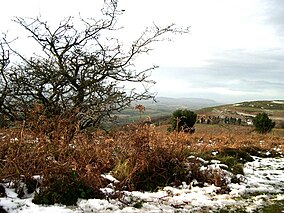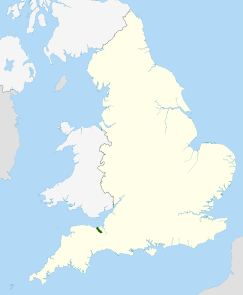
Back تلال كوانتوك ARZ Quantock Hills CEB Quantock Hills German Collines Quantock French Quantock Hills Italian Quantock Hills NN Quantock Hills Polish Quantock Hills Swedish 匡托克丘陵 Chinese
| Quantock Hills | |
|---|---|
 Upland scrub in the Quantocks | |
 Location of the Quantock Hills AONB in the UK | |
| Location | Somerset, England |
| Coordinates | 51°08′39″N 3°13′59″W / 51.14417°N 3.23306°W |
| Area | 38 sq mi (98 km2) |
| Governing body | Quantock Hills AONB |
| Website | Quantock Hills AONB |
The Quantock Hills west of Bridgwater in Somerset, England, consist of heathland, oak woodlands, ancient parklands and agricultural land. They were England's first Area of Outstanding Natural Beauty, designated in 1956.[1]
Natural England have designated the Quantock Hills as a national character area. They are entirely surrounded by another: the Vale of Taunton and Quantock Fringes.[2]
The hills run from the Vale of Taunton Deane in the south, for about 15 miles (24 km) to the north-west, ending at Kilve and West Quantoxhead on the coast of the Bristol Channel. They form the western border of Sedgemoor and the Somerset Levels. From the top of the hills on a clear day, it is possible to see Glastonbury Tor and the Mendips to the east, Wales as far as the Gower Peninsula to the north, the Brendon Hills and Exmoor to the west, and the Blackdown Hills to the south. The highest point on the Quantocks is Wills Neck, at 1,261 feet (384 m).[3] Soil types and weather combine to support the hills' plants and animals. In 1970, an area of 6,194.5 acres (2,506.8 ha) was designated as a Biological Site of Special Scientific Interest.[4]
Archaeological landscape features include Bronze Age round barrows, extensive ancient field systems and Iron Age hill forts. Roman silver coins have been discovered in West Bagborough. The hills are popular with walkers, mountain bikers, horse riders and tourists who explore paths such as the Coleridge Way.
- ^ "Quantock Hills AONB Service Website". Quantock Hills AONB. Somerset County Council. Archived from the original on 7 February 2012. Retrieved 18 April 2011.
- ^ NCA 146: Vale of Taunton & Quantock Fringes Key Facts & Data at www.naturalengland.org.uk. Retrieved 4 October 2013
- ^ Leete-Hodge, Lornie (1985). Curiosities of Somerset. Bodmin: Bossiney Books. p. 41. ISBN 0-906456-98-3.
- ^ "The Quantocks" (PDF). English Nature. Retrieved 24 January 2007.